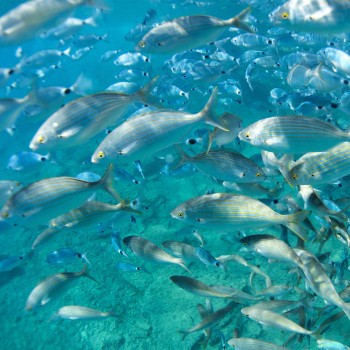The other day the food blog Grub Street ran a story about seafood you can eat without having a terrible impact on the environment. The article focused mainly on sustainable East Coast seafood, so for a more global perspective, Brendan got hold of Ryan Bigelow of the Monterey Bay Aquarium Seafood Watch. They monitor the fishing industry and rate what kinds of seafood are most sustainable.
Brendan started their chat with the big question: Is it actually OK to eat fish at all?
“The short answer is yes, go ahead and fish,” Ryan said. “The longer and more interesting answer is that people know a lot about terrestrial farming. Everyone has their own sort of code of ethics about what they’re willing to eat and what they don’t want to eat, for whatever reason. But for some reason, when it comes to fish and seaweed and anything we eat from the sea, people get confused.”
So, to cut around the confusion, Ryan offers this simple rule to follow: “If you have an ethic about what you eat from the land, you can just apply that to the water. And that information is pretty readily available through organizations like ours and others.”
The Monterey Bay Aquarium actually has an app that lists all the information on sustainable seafood. But for those who haven’t downloaded it yet or don’t have the time, you can get a few tips from the highlights below.
Interview Highlights:
When it comes to salmon, eat domestic
The rule of thumb on salmon — if you don’t have the app open in front of you — is start with a domestic. So, it’s probably going to be Alaskan. There’s also California, Oregon, Washington. But a domestic wild salmon would have the best product for the environment.
That’s because if you go back 20 years, salmon farms, in many cases, weren’t doing the best job with their chemical use, with the amount of fish that they were putting into their ponds or their nets, with the amount of escapes they’re allowing, many different issues. To be perfectly honest, those farms have done a lot to improve — not all of them.
So if you see a product that says “Atlantic Salmon,” that is definitely farmed, and you’re going to want to dig deeper. So, if you’re in the grocery store, if you’re in a restaurant, if it’s wild, that’s a great place to start.
Stay away from bluefin tuna
So, just a couple really quick rules of thumb. One, if you’re in a sushi restaurant, don’t eat bluefin tuna. I know it’s delicious. It has that meaty flavor we all love, but there is — at this point — no sustainable source of that. And the population is in really, really bad shape.
But that doesn’t mean you can’t eat tuna. There are good sources of tuna. What you really want to look for, in this case, are what are called pole and line fisheries. And again, it’s like grass-fed beef. If it’s caught in that way, it’s going to be labeled that way.
What you should look for when buying shrimp, the most-consumed seafood in the United States
The quick answer is: look for a domestic product if you can find it. That’s a little bit more difficult than with salmon because there’s just not as much of it. If you’re going to buy imported shrimp, know that it likely is farmed. You want to have your app out and ready.
Consider adding Rockfish to your seafood roster
I think most people know [Rockfish] as a word, but the rockfish fishery, especially on the West Coast of the United States, 15 years ago was a disaster. It was a nightmare.
The fishery was closed, and all of those fisheries on the West Coast* — a variety of different species that are caught — have all turned around. They’re all either — in our system — either a green or a yellow now. So “best choice” or “good alternative,” which is an amazing turnaround.
We can’t claim responsibility for that. That was fishermen and government and NGOs all coming together. But now you’ve got this amazing success story and a product, this rockfish, which is very well liked by U.S. chefs. It’s that nice, firm white meat that chefs tend to prefer.
The future looks bright for seafood lovers
You know, I am optimistic. And I think I’m optimistic because businesses are really on board now. Fifteen years ago, when we started, we would have to ask consumers, “Go into the store. Ask how it was caught. Ask where it was caught. Make sure you have the right species.”
But now I can say to a consumer, “Just go to one of these stores that’s on board and you don’t have to think about it.” So, in that sense, it’s much simpler for the consumer in a lot of ways. And then, as a movement, we’re really starting to ask those hard questions, which I think shows an evolution, right? What do you do about global warming and its impacts on fisheries?
And we’re working on that right now. So, the movement has matured, and the oceans feed so many people that we can’t afford not to succeed.


